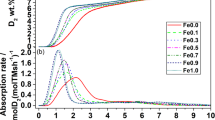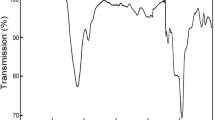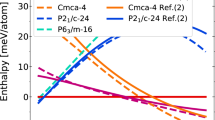Abstract
IT has long been known from measurements of specific heat1 that solid hydrogen chloride undergoes a first order phase transition at about 98.4° K. A similar phase transition was later found2 in solid deuterium chloride at about 105.0° K. X-ray powder photographs3 revealed that the crystal structure of hydrogen chloride was orthorhombic below the transition point and cubic above it. They also indicated that the chlorine atoms formed a face-centred lattice in both phases, but gave no clue regarding the location of the hydrogen atoms. Subsequent dielectric constant4, infra-red and Raman spectra5 and nuclear magnetic resonance6 investigations resulted in a variety of structural models for both phases of solid hydrogen chloride. Nevertheless, the indirect character of the structural information provided by these investigations did not allow an unambiguous choice between the various models.
This is a preview of subscription content, access via your institution
Access options
Subscribe to this journal
Receive 51 print issues and online access
$199.00 per year
only $3.90 per issue
Buy this article
- Purchase on Springer Link
- Instant access to full article PDF
Prices may be subject to local taxes which are calculated during checkout
Similar content being viewed by others
References
Eucken, A., and Karwat, E., Z. Phys. Chem., 112, 467 (1924). Giauque, W. F., and Wiebe, R., J. Amer. Chem. Soc., 50, 101 (1928). Clusius, K., Z. Phys. Chem., B, 3, 41 (1929).
Clusius, K., and Wolf, G., Z. Naturforsch., 2 a, 495 (1947).
Simon, F., and Simson, C., Z. Phys., 21, 168 (1924). Natta, G., Gaz. Chim. Ital., 63, 425 (1933).
Cone, R. M., Dennison, G. H., and Kemp, J. D., J. Amer. Chem. Soc., 53, 1278 (1931). Smyth, C. P., and Hitchcock, C. S., J. Amer. Chem. Soc., 55, 1830 (1933). Hettner, G., and Pohlman, R., Z. Phys., 108, 45 (1938). Phillips, C. S. E., J. Phys. Radium, 13, 216 (1952).
Hettner, G., Z. Phys., 78, 141 (1932); Z. Phys., 89, 234 (1934). Lee, E., Sutherland, G. B. B. M., and Wu, C. K., Nature, 142, 669 (1938): Proc. Roy. Soc., A, 176, 493 (1940). Hornig, D. F., and Osberg, W. E., J. Chem. Phys., 23, 662 (1955). Anderson, A., Walmsley, S. H., and Gebbie, H. A., Phil. Mag., 7, 1243 (1962). Friedrich, H. B., and Person, W. B., J. Chem. Phys., 39, 811 (1963). Anderson, A., Gebbie, H. A., and Walmsley, S. H., Mol. Phys., 7, 401 (1964). Savoie, R., and Anderson, A., J. Chem. Phys., 44, 548 (1966).
Alpert, N. L., Phys. Rev., 75, 398 (1949).
Author information
Authors and Affiliations
Rights and permissions
About this article
Cite this article
SÁNDOR, E., FARROW, R. Crystal Structure of Solid Hydrogen Chloride and Deuterium Chloride. Nature 213, 171–172 (1967). https://doi.org/10.1038/213171a0
Received:
Issue Date:
DOI: https://doi.org/10.1038/213171a0
Comments
By submitting a comment you agree to abide by our Terms and Community Guidelines. If you find something abusive or that does not comply with our terms or guidelines please flag it as inappropriate.



